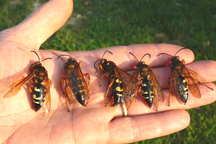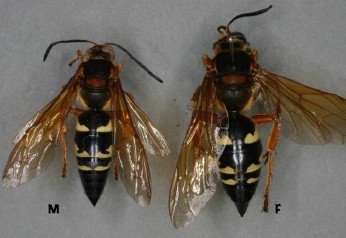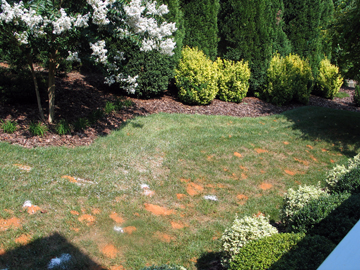|
Cicada Killer
Cicada killer wasps (genus ''Sphecius'') are large, solitary, ground-dwelling, predatory wasps. They are so named because they hunt cicadas and provision their nests with them, after stinging and paralyzing them. Twenty-one species worldwide are recognized. The highest diversity occurs in the region between North Africa and Central Asia. In North America, the term "cicada killer wasp" usually refers to the most well-known species, the eastern cicada killer (''S. speciosus''). A few other related genera also are sometimes referred to as "cicada killers", e.g. ''Liogorytes'' in South America and ''Exeirus'' in Australia. The use of cicadas as prey is in keeping with the typical behavior of the tribe Bembicini, which tend to specialize on various members of the Cicadomorpha as prey items. Species This list of species is probably complete as of March 31, 2009. It has been adapted from thCatalog of ''Sphecius'' species(California Academy of Sciences). Notable subspecies are also gi ... [...More Info...] [...Related Items...] OR: [Wikipedia] [Google] [Baidu] [Amazon] |
Eastern Cicada Killer
''Sphecius speciosus'', the eastern cicada-killer wasp, is a large, solitary Wasp, digger wasp species in the Family (biology), family Bembicidae. They are so named because they hunt cicadas and provision their nests with them. Cicada killers exert a measure of natural control on cicada populations, and as such, they may directly benefit the deciduous trees upon which the cicadas feed. Sometimes, they are erroneously called sand hornets, despite not truly being hornets, which belong to the family Vespidae. The most recent review of this species' biology is found in the posthumously published comprehensive study by noted Entomology, entomologist Howard Ensign Evans. Distribution This species can be found in the Eastern and Midwest U.S. and southwards into Mexico and Central America. Description Adult eastern cicada wasps are large, long, robust wasps with hairy, reddish, and black areas on their thoraces (middle parts), and black to reddish brown abdominal (rear) segments t ... [...More Info...] [...Related Items...] OR: [Wikipedia] [Google] [Baidu] [Amazon] |
Sphecius Grandidieri
Cicada killer wasps (genus ''Sphecius'') are large, solitary, ground-dwelling, predatory wasps. They are so named because they hunt cicadas and provision their nests with them, after stinging and paralyzing them. Twenty-one species worldwide are recognized. The highest diversity occurs in the region between North Africa and Central Asia. In North America, the term "cicada killer wasp" usually refers to the most well-known species, the eastern cicada killer (''S. speciosus''). A few other related genera also are sometimes referred to as "cicada killers", e.g. '' Liogorytes'' in South America and '' Exeirus'' in Australia. The use of cicadas as prey is in keeping with the typical behavior of the tribe Bembicini, which tend to specialize on various members of the Cicadomorpha as prey items. Species This list of species is probably complete as of March 31, 2009. It has been adapted from thCatalog of ''Sphecius'' species(California Academy of Sciences). Notable subspecies are also ... [...More Info...] [...Related Items...] OR: [Wikipedia] [Google] [Baidu] [Amazon] |
Sphecius Grandis
''Sphecius grandis'', also called the western cicada killer, is a species of cicada killer wasp (''Sphecius''). The western species shares the same nesting biology as its fellow species, the eastern cicada killer ('' S. speciosus''). ''S. grandis'', like all other species of the genus ''Sphecius'', mainly provides cicadas for its offspring. It forms nest aggregations and mates and broods once in a year, in July and early August. The wasp is on average to in length and is amber-yellow with yellow rings on its abdomen. Wasps in the genus ''Sphecius'' are not habitually aggressive and use their venom mainly to paralyse cicadas which they take back to their nests to feed their young. The females catch around four or more cicadas for provisioning, place them in brood cells and lay eggs in the cells. ''S. grandis'' is endemic to Central America, Mexico and the Western United States, and is found at a higher mean altitude than other species of ''Sphecius''. The western ci ... [...More Info...] [...Related Items...] OR: [Wikipedia] [Google] [Baidu] [Amazon] |
Western Cicada Killer
''Sphecius grandis'', also called the western cicada killer, is a species of Sphecius, cicada killer wasp (''Sphecius''). The western species shares the same Nest, nesting biology as its fellow species, the eastern cicada killer (''Sphecius speciosus, S. speciosus''). ''S. grandis'', like all other species of the genus ''Sphecius'', mainly provides cicadas for its offspring. It forms nest aggregations and mates and Voltinism, broods once in a year, in July and early August. The wasp is on average to in length and is amber-yellow with yellow rings on its abdomen. Wasps in the genus ''Sphecius'' are not habitually aggressive and use their venom mainly to paralyse cicadas which they take back to their nests to feed their young. The females catch around four or more cicadas for provisioning, place them in brood cells and lay eggs in the cells. ''S. grandis'' is Endemism, endemic to Central America, Mexico and the Western United States, and is found at a higher mean altitu ... [...More Info...] [...Related Items...] OR: [Wikipedia] [Google] [Baidu] [Amazon] |
Sphecius Hemixanthopterus
Cicada killer wasps (genus ''Sphecius'') are large, solitary, ground-dwelling, predatory wasps. They are so named because they hunt cicadas and provision their nests with them, after stinging and paralyzing them. Twenty-one species worldwide are recognized. The highest diversity occurs in the region between North Africa and Central Asia. In North America, the term "cicada killer wasp" usually refers to the most well-known species, the eastern cicada killer (''S. speciosus''). A few other related genera also are sometimes referred to as "cicada killers", e.g. '' Liogorytes'' in South America and '' Exeirus'' in Australia. The use of cicadas as prey is in keeping with the typical behavior of the tribe Bembicini, which tend to specialize on various members of the Cicadomorpha as prey items. Species This list of species is probably complete as of March 31, 2009. It has been adapted from thCatalog of ''Sphecius'' species(California Academy of Sciences). Notable subspecies are also ... [...More Info...] [...Related Items...] OR: [Wikipedia] [Google] [Baidu] [Amazon] |
Sphecius Speciosus
''Sphecius speciosus'', the eastern cicada-killer wasp, is a large, solitary digger wasp species in the family Bembicidae. They are so named because they hunt cicadas and provision their nests with them. Cicada killers exert a measure of natural control on cicada populations, and as such, they may directly benefit the deciduous trees upon which the cicadas feed. Sometimes, they are erroneously called sand hornets, despite not truly being hornets, which belong to the family Vespidae. The most recent review of this species' biology is found in the posthumously published comprehensive study by noted entomologist Howard Ensign Evans. Distribution This species can be found in the Eastern and Midwest U.S. and southwards into Mexico and Central America. Description Adult eastern cicada wasps are large, long, robust wasps with hairy, reddish, and black areas on their thoraces (middle parts), and black to reddish brown abdominal (rear) segments that are marked with light yellow st ... [...More Info...] [...Related Items...] OR: [Wikipedia] [Google] [Baidu] [Amazon] |
Central Asia
Central Asia is a region of Asia consisting of Kazakhstan, Kyrgyzstan, Tajikistan, Turkmenistan, and Uzbekistan. The countries as a group are also colloquially referred to as the "-stans" as all have names ending with the Persian language, Persian suffix "-stan" (meaning ) in both respective native languages and most other languages. The region is bounded by the Caspian Sea to the southwest, European Russia to the northwest, China and Mongolia to the east, Afghanistan and Iran to the south, and Siberia to the north. Together, the five Central Asian countries have a total population of around million. In the pre-Islamic and early Islamic eras ( and earlier) Central Asia was inhabited predominantly by Iranian peoples, populated by Eastern Iranian-speaking Bactrians, Sogdians, Khwarezmian language, Chorasmians, and the semi-nomadic Scythians and Dahae. As the result of Turkic migration, Central Asia also became the homeland for the Kazakhs, Kyrgyzs, Volga Tatars, Tatars, Turkmens, ... [...More Info...] [...Related Items...] OR: [Wikipedia] [Google] [Baidu] [Amazon] |


